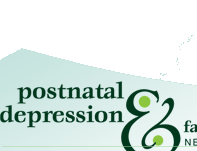 |
 |

|
|
|

GLOSSARYAbstinence: Not using a substance at all. Affect: The outward appearance (facial expressions, movements and behaviour) of an individuals mood. It may give an accurate indication of the underlying mood but it may also be quite misleading e.g. someone with depression may appear cheerful particularly for limited periods of time. Agoraphobia: Avoidance, usually caused by fear of having a panic attack. Antenatal: before having the baby or before the birth. Anxiety: Worry, usually has: i) a cognitive component which is the mental worries and worrying thoughts; ii) a physical component such as heart racing, feeling tense, not breathing in a calm manner, shaking, feeling churned up in the stomach. Anxiety can interfere with the ability to think and communicate clearly. Behaviour: What we do and how we do it. Binge Drinking: For women this is defined as more than four units of alcohol in one session Bipolar I Disorder: A mood disorder where a person has experienced at least one manic episode. They usually (but not always) also suffer from depressive episodes and in fact most people with Bipolar Disorder find the depressions are the most debilitating part of the illness. Bipolar II Disorder: A mood disorder where a person has experienced at least one hypomanic episode but has not experienced a manic episode. As with Bipolar I disorder they usually (but not always) also suffer from depressive episodes which are often the most debilitating part of the illness. Bipolar NOS or Bipolar Disorder Not Otherwise Specified: A mood disorder with significant symptoms of hypomania but where the full criteria of hypomania are not met. One of the most common ways in which this occurs is for someone to be hypomanic but not for as long as the 4 days required to meet the criteria for hypomania. CBT: Cognitive behaviour therapy/treatment. See Treatment section. Cognitions: Thoughts. Compulsion: A behaviour that is carried out for mental relief rather than for any other purpose. There is usually a repetitive nature to it. E.g. repeatedly wiping a kitchen bench which is already clean, or checking that a heater is turned off repeatedly. Delusion: A firmly held belief that is not real and is not consistent with (or explained by) the individuals culture or religion. Dissociation: Feeling disconnected from yourself as if you are currently not part of you immediate environment. Derealisation: Feeling disconnected from your environment and as if the environment is not real. EPDS: Edinburgh Postnatal Depression Questionnaire. Episode: This usually refers to a discrete period of time when symptoms of a condition are occurring to a sufficient extent to say that a person is unwell. Fertility Treatments: Treatments aimed at improving the chance of conceiving (becoming pregnant). GAD: Generalised Anxiety Disorder See anxiety section above. Hallucination: This is a perception (sight, sound, vision, taste, or touch) that is not real but which the person experiences as real. Some hallucinations, such as those happening when going to sleep or waking up, are not necessarily part of an illness. Hallucinations can occur as part of several different illnesses including for example, if someone has a high fever. Hyperventilation: Breathing too fast or too much causing a lowering in blood levels of carbon dioxide and an increase in blood levels of oxygen. Hypervigilance: Being excessively vigilant or watchful, scanning the environment looking for signs of danger. Hypomanic Episode: Hypomania is 'a little' mania. ie it has the same type of symptoms but not as severe. Implantation: the embryo is embedded in the womb and deriving nutrition from the mother Insomnia: Inability to sleep. IPT: Interpersonal psychotherapy. See Treatment section. Major Depressive Episode: This refers to at two week period (or longer) when a person suffers from the symptoms of depression for most of the time. Those symptoms include depressed mood or loss of interest or pleasure in most activities, loss of energy and motivation, sleep and appetite disturbance, impaired concentration and memory and negative thoughts. Manic Episode: This is when a number of symptoms occur together over at least a one week period. The symptoms include abnormally and persistently elevated, expansive, or irritable mood, inflated self-esteem, reduced need for sleep, increased talkativeness, exceassive distractability and disinhibited behaviour which might lead to unwanted consequences. Miscarriage: Also known as spontaneous abortion (not the same as a planned abortion). The end, by natural causes of a pregnancy where the embryo or foetus is incapable of surviving. Generally defined, in humans as a pregnancy of less than 20 weeks. Neonate: A newborn baby. NICU: Neonatal Intensive Care Unit Obsession: A thought that keeps coming into ones mind and keeps repeating itself. People usually do not want to have the thought and will often engage in compulsive behaviours to get rid of the thought. Obsessive-Compulsive: Having obsessions and behaving compulsively as a way of dealing with the obsessions. Obsessive-Compulsive Disorder: This is present when obsessions and/or compulsions are present for a significant portion of the day and interfere with functioning. Panic Attack: The rapid onset of extreme anxiety and fear, for no apparent reason. A panic attack usually lasts for five to ten minutes though marked anxiety may persist longer than this. PHARMAC; Pharmaceutical Management Agency. A New Zealand, government funded agency which decides which medications will be funded/subsidised by the government. Phobia: Fear of something that results in an individual avoiding or attempting to avoid the object/place/situation/person or animal/insect. PND: This is the common abbreviation for postnatal depression. Postnatal: After having a baby, after the birth. Postpartum: After having a baby, after the birth. Posttraumatic Stress Disorder: This is said to be present if someone has been exposed to an event in which they perceived themselves or others to be at risk of death or serious injury and their response involves intense fear, horror or helplessness and following this, the traumatic experience is 'reexperienced' the feeling of intense fear continues and they persistently avoid reminders of the trauma. Prophylaxis: Preventive. Prophylactic medication is medication aimed to prevent or reduce the likelihood of the illness recurring. Psychosis: A psychiatric term for a state involving a loss of contact with reality where a person often experiences delusions and hallucinations PTSD: Post-traumatic stress disorder. See above. Puerperal: After birth. Risk Factors: These are factors which have been shown statistically to be associated with a condition. They are not necessarily the cause of the condition. Side Effect: These are the unwanted but not usually dangerous effects of a medication. SIDS: Abbreviation for Sudden Infant Death Syndrome otherwise known as cot death. Sign: This refers to something in a person which is able to be identified by a health professional as indicating an underlying condition. It is objective evidence of the presence of a condition or illness. Social Phobia: Fear of social situations because one is self conscious and worried about being judged or criticised. Results in an individual avoiding social situations/interactions. See section on anxiety. Stillbirth: The death of a foetus in the womb or during birth. Usually applied if the foetus is over 24 weeks gestation. Substance Abuse: The use of legal (such as alcohol and cigarettes) and illegal (e.g. cannabis) drugs in a manner which is physically harmful or damaging to functioning e.g. ability to be able to parent or to function at work. Damage to relationships or legal consequences can also be features of substance abuse. Symptom: This refers to the subjective experiences of a person who is suffering from a condition or illness and which are attributed to that condition or illness. Teratogen: An agent which raises the risk of congential malformation Teratogenic: Acting as a teratogen, ie acting to increase the risk of congenital malformation Toxic Effect: These are the effects of a medication when too much is taken. Toxic effects are often harmful and dangerous. These are not the same as side-effects. Trimester: Pregnancy is considered in three parts; the first trimester which is the first 12-14 weeks, the second trimester which is the middle 12-14 weeks and the third trimester which is the last 12-14 weeks. A standard length of pregnancy is 40 weeks. |
Home | About us | Baby | Books & Links | Contact Us | Culture | Fact Sheets | Family/Whanau | Fathers | Glossary | Medical Info | Medications | Post Natal Depression | Pregnancy | Q&A | Related Conditions | Stories | Support | Treatments |